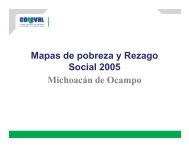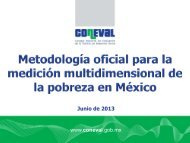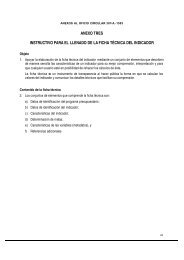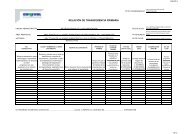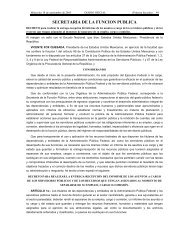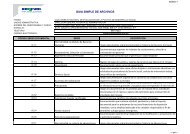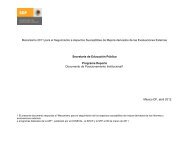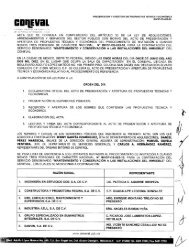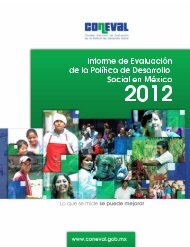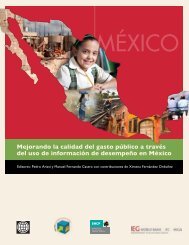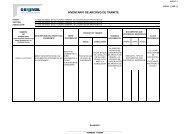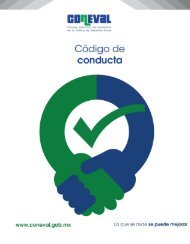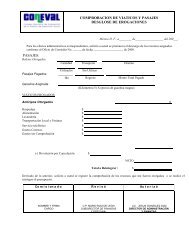CONEVAL informa los resultados de la medición de pobreza 2010
CONEVAL informa los resultados de la medición de pobreza 2010
CONEVAL informa los resultados de la medición de pobreza 2010
You also want an ePaper? Increase the reach of your titles
YUMPU automatically turns print PDFs into web optimized ePapers that Google loves.
DIRECCIÓN DE INFORMACIÓN Y COMUNICACIÓN SOCIAL<br />
COMUNICADO DE PRENSA No.007<br />
México, Distrito Fe<strong>de</strong>ral a 29 <strong>de</strong> julio <strong>de</strong> 2011<br />
<strong>CONEVAL</strong> INFORMA LOS RESULTADOS DE LA MEDICIÓN DE LA POBREZA <strong>2010</strong><br />
Entre 2008 y <strong>2010</strong> se redujeron <strong>la</strong>s carencias sociales <strong>de</strong> acceso a <strong>los</strong> servicios <strong>de</strong> salud;<br />
acceso a <strong>la</strong> seguridad social; servicios básicos en <strong>la</strong> vivienda; calidad y espacios <strong>de</strong> <strong>la</strong><br />
vivienda, y rezago educativo.<br />
En el mismo periodo, en el contexto <strong>de</strong> <strong>la</strong> crisis económica, el ingreso real <strong>de</strong> <strong>los</strong> hogares se<br />
redujo, especialmente en <strong>la</strong>s áreas urbanas.<br />
Asimismo, se registró un incremento <strong>de</strong> <strong>la</strong> pob<strong>la</strong>ción que carece <strong>de</strong> acceso a <strong>la</strong><br />
alimentación.<br />
Como consecuencia <strong>de</strong> lo antes seña<strong>la</strong>do, entre 2008 y <strong>2010</strong> <strong>la</strong> pob<strong>la</strong>ción en <strong>pobreza</strong> pasó<br />
<strong>de</strong> 44.5% a 46.2%, lo que representa un incremento <strong>de</strong> 48.8 a 52.0 millones <strong>de</strong> personas.<br />
En el mismo periodo, <strong>la</strong> pob<strong>la</strong>ción en <strong>pobreza</strong> extrema pasó <strong>de</strong> 10.6% a 10.4%; en términos<br />
<strong>de</strong>l número <strong>de</strong> personas en situación <strong>de</strong> <strong>pobreza</strong> extrema, éste se mantuvo en 11.7<br />
millones.<br />
México, D.F.- El Consejo Nacional <strong>de</strong> Evaluación <strong>de</strong> <strong>la</strong> Política <strong>de</strong> Desarrollo Social (<strong>CONEVAL</strong>) da<br />
a conocer <strong>los</strong> <strong>resultados</strong> <strong>de</strong> <strong>la</strong> medición <strong>de</strong> <strong>pobreza</strong> <strong>2010</strong> para cada entidad fe<strong>de</strong>rativa y para el<br />
país en su conjunto, <strong>informa</strong>ción que fortalece <strong>la</strong> transparencia y <strong>la</strong> rendición <strong>de</strong> cuentas en <strong>la</strong><br />
política social.<br />
La medición <strong>de</strong> <strong>pobreza</strong>, como lo establece <strong>la</strong> Ley General <strong>de</strong> Desarrollo Social, incluye <strong>los</strong><br />
siguientes factores: ingreso, rezago educativo, acceso a <strong>los</strong> servicios <strong>de</strong> salud, acceso a <strong>la</strong><br />
seguridad social, calidad y espacios <strong>de</strong> <strong>la</strong> vivienda, servicios básicos en <strong>la</strong> vivienda, acceso a <strong>la</strong><br />
alimentación y grado <strong>de</strong> cohesión social.<br />
EVOLUCIÓN DE LAS DIMENSIONES DE LA POBREZA 2008-<strong>2010</strong><br />
Evolución <strong>de</strong> <strong>la</strong>s carencias sociales<br />
Entre 2008 y <strong>2010</strong> en casi todas <strong>la</strong>s entida<strong>de</strong>s fe<strong>de</strong>rativas disminuyeron <strong>la</strong>s carencias <strong>de</strong> acceso a<br />
<strong>los</strong> servicios <strong>de</strong> salud, acceso a <strong>la</strong> seguridad social, acceso a <strong>los</strong> servicios básicos en <strong>la</strong> vivienda, <strong>la</strong><br />
carencia por <strong>la</strong> falta <strong>de</strong> calidad y espacios <strong>de</strong> <strong>la</strong> vivienda, así como el rezago educativo. 1<br />
1 Las estimaciones <strong>de</strong> 2006 y <strong>de</strong> 2008 que se presentan en este comunicado utilizan <strong>la</strong>s bases <strong>de</strong> datos<br />
dadas a conocer este mes por el INEGI, una vez que han sido expandidas conforme a <strong>la</strong>s estimaciones<br />
preliminares <strong>de</strong> pob<strong>la</strong>ción realizadas por el Instituto con base en <strong>la</strong> magnitud y distribución <strong>de</strong> <strong>la</strong> pob<strong>la</strong>ción<br />
proveniente <strong>de</strong>l Censo <strong>de</strong> Pob<strong>la</strong>ción y Vivienda <strong>2010</strong>, por lo que difieren <strong>de</strong> <strong>la</strong>s publicadas anteriormente.<br />
1
DIRECCIÓN DE INFORMACIÓN Y COMUNICACIÓN SOCIAL<br />
Acceso a <strong>los</strong> servicios <strong>de</strong> salud<br />
La falta <strong>de</strong> acceso a servicios <strong>de</strong> salud se redujo <strong>de</strong> 40.8% (44.8 millones <strong>de</strong> personas) a 31.8%<br />
(35.8 millones <strong>de</strong> personas) entre 2008 y <strong>2010</strong>.<br />
Las entida<strong>de</strong>s fe<strong>de</strong>rativas con mayor disminución porcentual en <strong>la</strong> carencia <strong>de</strong> acceso a <strong>los</strong><br />
servicios <strong>de</strong> salud son San Luis Potosí (42.3%), Chihuahua (35.4%), Hidalgo (35.3%), Michoacán<br />
(31.6%) y Guerrero (31.4%). Sonora (3.7%) es <strong>la</strong> única entidad fe<strong>de</strong>rativa don<strong>de</strong> aumentó esta<br />
carencia.<br />
Acceso a <strong>la</strong> seguridad social<br />
A nivel nacional esta carencia pasó <strong>de</strong> 65.0% (71.3 millones <strong>de</strong> personas) a 60.7% (68.3 millones<br />
<strong>de</strong> personas).<br />
Las entida<strong>de</strong>s fe<strong>de</strong>rativas con mayor disminución porcentual en <strong>la</strong> carencia por acceso a <strong>la</strong><br />
seguridad social son Nuevo León (16.0%), Coahui<strong>la</strong> (15.3%), el Estado <strong>de</strong> México (13.6%),<br />
Chihuahua (13.2%) y Aguascalientes (11.3%). Querétaro (5.3%) es <strong>la</strong> única entidad fe<strong>de</strong>rativa<br />
don<strong>de</strong> esta carencia se incrementó.<br />
Servicios básicos en <strong>la</strong> vivienda<br />
A nivel nacional, entre 2008 y <strong>2010</strong> <strong>la</strong> carencia <strong>de</strong> servicios básicos en <strong>la</strong> vivienda pasó <strong>de</strong> 19.2%<br />
(21.1 millones <strong>de</strong> personas) a 16.5% (18.5 millones <strong>de</strong> personas).<br />
Las entida<strong>de</strong>s fe<strong>de</strong>rativas con mayor disminución porcentual en <strong>la</strong> carencia son Nuevo León<br />
(66.4%), Chihuahua (44.0%), Pueb<strong>la</strong> (29.8%), Yucatán (28.3%) y Sinaloa (27.8%) y Tamaulipas<br />
(30.9%), Tabasco (17.0%), Sonora (16.0%), Zacatecas (13.2%) y Colima (11.8%), <strong>la</strong>s <strong>de</strong> mayores<br />
aumentos.<br />
Calidad y espacios <strong>de</strong> <strong>la</strong> vivienda<br />
En el país, entre 2008 y <strong>2010</strong>, el porcentaje <strong>de</strong> pob<strong>la</strong>ción con carencias asociadas a <strong>la</strong> calidad y<br />
espacios <strong>de</strong> <strong>la</strong> vivienda disminuyó <strong>de</strong> 17.7% (19.4 millones <strong>de</strong> personas) a 15.2% (17.1 millones <strong>de</strong><br />
personas).<br />
Las entida<strong>de</strong>s fe<strong>de</strong>rativas con <strong>la</strong>s mayores disminuciones porcentuales en esta carencia son<br />
Chihuahua (43.1%), Sinaloa (41.1%), Zacatecas (38.8%), Hidalgo (35.8%) y Jalisco (31.7%),<br />
mientras que <strong>la</strong>s que presentan <strong>los</strong> mayores incrementos porcentuales son Baja California (27.2%),<br />
Tabasco (24.8%), Distrito Fe<strong>de</strong>ral (19.7%) y Colima (8.8%).<br />
Rezago educativo<br />
El rezago educativo se redujo <strong>de</strong> 21.9% (24.1 millones <strong>de</strong> personas) a 20.6% (23.2 millones <strong>de</strong><br />
personas) entre 2008 y <strong>2010</strong>.<br />
Las entida<strong>de</strong>s fe<strong>de</strong>rativas con mayor disminución porcentual <strong>de</strong>l rezago educativo son Tamaulipas<br />
(16.4%), Durango (13.9%), Sonora (13.2%), Nuevo León (12.4%) y T<strong>la</strong>xca<strong>la</strong> (12.1%). Por otro <strong>la</strong>do,<br />
esta carencia aumentó en <strong>la</strong>s siguientes entida<strong>de</strong>s: Campeche (5.3%), Baja California Sur (2.3%) y<br />
Colima (0.6%).<br />
2
DIRECCIÓN DE INFORMACIÓN Y COMUNICACIÓN SOCIAL<br />
Acceso a <strong>la</strong> alimentación<br />
En el país, el porcentaje <strong>de</strong> personas con carencia por acceso a <strong>la</strong> alimentación pasó <strong>de</strong> 21.7%<br />
(23.8 millones <strong>de</strong> personas) a 24.9% (28.0 millones <strong>de</strong> personas) entre 2008 y <strong>2010</strong>.<br />
Baja California Sur (68.1%), Campeche (53.7%), el Estado <strong>de</strong> México (49.2%), Quintana Roo<br />
(47.2%) y Nuevo León (45.9%) son <strong>la</strong>s entida<strong>de</strong>s don<strong>de</strong> aumentó en mayor medida <strong>la</strong> carencia <strong>de</strong><br />
acceso a <strong>la</strong> alimentación, aunque ésta también aumentó en otros 19 estados. Por el contrario,<br />
Guanajuato (12.4%), More<strong>los</strong> (12.0%), Michoacán (9.6%), Durango (8.8%) y Oaxaca (6.8%) son<br />
estados que lograron disminuir<strong>la</strong>.<br />
Evolución <strong>de</strong>l ingreso<br />
La metodología empleada en el país para medir <strong>la</strong> <strong>pobreza</strong> incorpora dos umbrales <strong>de</strong> ingreso: <strong>la</strong><br />
línea <strong>de</strong> bienestar, que se <strong>de</strong>termina como <strong>la</strong> suma <strong>de</strong>l costo <strong>de</strong> <strong>la</strong> canasta alimentaria y <strong>la</strong> no<br />
alimentaria, y <strong>la</strong> línea <strong>de</strong> bienestar mínimo, <strong>la</strong> cual es igual al costo <strong>de</strong> <strong>la</strong> canasta alimentaria.<br />
Estas líneas permiten valorar el porcentaje <strong>de</strong> personas con ingresos insuficientes para satisfacer<br />
sus necesida<strong>de</strong>s básicas.<br />
En agosto <strong>de</strong> <strong>2010</strong> el valor <strong>de</strong> <strong>la</strong> línea <strong>de</strong> bienestar fue <strong>de</strong> $2,114 pesos mensuales por persona en<br />
<strong>la</strong>s áreas urbanas y <strong>de</strong> $1,329 pesos en <strong>la</strong>s rurales. Los valores correspondientes <strong>de</strong> <strong>la</strong> línea <strong>de</strong><br />
bienestar mínimo fueron $978 pesos y $684 pesos, respectivamente.<br />
Las entida<strong>de</strong>s fe<strong>de</strong>rativas don<strong>de</strong> más se redujo el porcentaje <strong>de</strong> <strong>la</strong> pob<strong>la</strong>ción por <strong>de</strong>bajo <strong>de</strong> <strong>la</strong> línea<br />
<strong>de</strong> bienestar son Coahui<strong>la</strong> (10.4%), More<strong>los</strong> (5.5%) y Pueb<strong>la</strong> (2.7%). Los mayores aumentos<br />
tuvieron lugar en Baja California Sur (35.9%), Chihuahua (31.6%), Colima (28.1%), Sonora (28.1%)<br />
y Sinaloa (23.1%).<br />
Respecto al porcentaje <strong>de</strong> pob<strong>la</strong>ción con ingresos inferiores a <strong>la</strong> línea <strong>de</strong> bienestar mínimo —<br />
umbral <strong>de</strong>terminado por el valor <strong>de</strong> <strong>la</strong> canasta alimentaria—, <strong>la</strong>s entida<strong>de</strong>s con <strong>la</strong>s mayores<br />
reducciones fueron More<strong>los</strong> (20.0%), Tabasco (9.9%), Quintana Roo (8.9%) y Michoacán (3.1%),<br />
mientras que <strong>los</strong> estados con <strong>los</strong> mayores incrementos fueron Sinaloa (73.4%), Jalisco (49.9%),<br />
Querétaro (46.2%), Baja California Sur (45.6%) y Chihuahua (43.9%).<br />
La evolución <strong>de</strong>l ingreso muestra un patrón diferente en <strong>la</strong>s áreas urbanas y rurales: en <strong>la</strong>s<br />
primeras, el porcentaje <strong>de</strong> personas con un ingreso menor a <strong>la</strong> línea <strong>de</strong> bienestar pasó <strong>de</strong> 44.8% en<br />
2008 a 47.7% en <strong>2010</strong>; por otra parte, en <strong>la</strong>s áreas rurales pasó <strong>de</strong> 63.1% a 66.0%, en estos años.<br />
A nivel nacional, el porcentaje <strong>de</strong> pob<strong>la</strong>ción que dispone <strong>de</strong> ingresos inferiores <strong>de</strong> <strong>la</strong> línea <strong>de</strong><br />
bienestar aumentó <strong>de</strong> 49.0% a 52.0% entre 2008 y <strong>2010</strong>, mientras que el porcentaje con un<br />
ingreso menor a <strong>la</strong> línea <strong>de</strong> bienestar mínimo pasó <strong>de</strong> 16.7% a 19.4%. Estos cambios se dieron<br />
en el contexto <strong>de</strong> una crisis económica mundial que afectó el <strong>de</strong>sempeño económico <strong>de</strong>l país.<br />
EVOLUCIÓN DE LA POBREZA Y DE LA POBREZA EXTREMA<br />
Evolución <strong>de</strong> <strong>la</strong> <strong>pobreza</strong><br />
3
DIRECCIÓN DE INFORMACIÓN Y COMUNICACIÓN SOCIAL<br />
La <strong>de</strong>finición <strong>de</strong> <strong>pobreza</strong> indica que son pobres quienes tienen al menos una carencia social y un<br />
ingreso menor a <strong>la</strong> línea <strong>de</strong> bienestar. Tal como se señaló previamente, entre 2008 y <strong>2010</strong> se<br />
registró el mejoramiento <strong>de</strong> algunas dimensiones <strong>de</strong> <strong>la</strong> <strong>pobreza</strong> y el empeoramiento <strong>de</strong> otras, lo que<br />
repercutió en <strong>la</strong> evolución <strong>de</strong> <strong>la</strong> <strong>pobreza</strong>.<br />
Entre 2008 y <strong>2010</strong>, <strong>la</strong>s entida<strong>de</strong>s fe<strong>de</strong>rativas que mostraron <strong>los</strong> mayores aumentos en el número <strong>de</strong><br />
personas en situación <strong>de</strong> <strong>pobreza</strong> fueron Veracruz, con un incremento <strong>de</strong> 3.9 a 4.5 millones <strong>de</strong><br />
personas pobres; Guanajuato, <strong>de</strong> 2.4 a 2.7 millones; Oaxaca, <strong>de</strong> 2.3 a 2.6 millones; Chihuahua y<br />
Tamaulipas, cada una con un incremento <strong>de</strong> 1.1 a 1.3 millones <strong>de</strong> personas pobres, y Baja<br />
California, don<strong>de</strong> aumentó <strong>de</strong> 800 mil a un millón el número <strong>de</strong> personas pobres.<br />
Los cambios en <strong>la</strong>s entida<strong>de</strong>s fe<strong>de</strong>rativas dieron como resultado que, a nivel nacional, aumentara<br />
<strong>de</strong> 44.5% a 46.2% el porcentaje <strong>de</strong> <strong>la</strong> pob<strong>la</strong>ción en situación <strong>de</strong> <strong>pobreza</strong>; que el número <strong>de</strong><br />
personas pobres pasara <strong>de</strong> 48.8 millones a 52.0 millones, y que se redujera <strong>de</strong> 2.7 a 2.5 el número<br />
medio <strong>de</strong> carencias sociales <strong>de</strong> <strong>la</strong> pob<strong>la</strong>ción pobre.<br />
Evolución <strong>de</strong> <strong>la</strong> <strong>pobreza</strong> extrema<br />
La pob<strong>la</strong>ción en <strong>pobreza</strong> extrema es <strong>la</strong> que tiene tres o más carencias sociales y un ingreso menor<br />
a <strong>la</strong> línea <strong>de</strong> bienestar mínimo. A nivel nacional, entre 2008 y <strong>2010</strong> el porcentaje <strong>de</strong> personas en<br />
<strong>pobreza</strong> extrema pasó <strong>de</strong> 10.6% a 10.4%. A pesar <strong>de</strong> que <strong>la</strong> <strong>pobreza</strong> extrema aumentó en 38 mil<br />
personas en dicho periodo, el número <strong>de</strong> pobres extremos resultó ser igual a 11.7 millones en<br />
ambos años.<br />
Las entida<strong>de</strong>s fe<strong>de</strong>rativas que tuvieron <strong>la</strong>s mayores reducciones en el número <strong>de</strong> pobres extremos<br />
entre 2008 y <strong>2010</strong> fueron Chiapas, que pasó <strong>de</strong> 1.7 a 1.6 millones <strong>de</strong> personas en esa situación;<br />
Pueb<strong>la</strong>, <strong>de</strong> un millón a 864 mil, y Michoacán, <strong>de</strong> 649 mil a 551 mil pobres extremos. Las entida<strong>de</strong>s<br />
con mayores aumentos fueron Veracruz (<strong>de</strong> 1.2 a 1.4 millones); el Estado <strong>de</strong> México (<strong>de</strong> 1.0 a 1.2<br />
millones), y Jalisco (<strong>de</strong> 319 mil a 362 mil personas en situación <strong>de</strong> <strong>pobreza</strong> extrema).<br />
Evolución <strong>de</strong> <strong>la</strong> pob<strong>la</strong>ción vulnerable<br />
De acuerdo con <strong>la</strong>s <strong>de</strong>finiciones <strong>de</strong> vulnerabilidad, una persona es vulnerable por carencias<br />
sociales si tiene al menos una carencia, aun cuando su ingreso sea mayor que <strong>la</strong> línea <strong>de</strong><br />
bienestar. Por otra parte, una persona es consi<strong>de</strong>rada vulnerable por ingreso si no tiene carencias<br />
sociales, pero sí un ingreso inferior al valor <strong>de</strong> <strong>la</strong> línea <strong>de</strong> bienestar.<br />
La pob<strong>la</strong>ción vulnerable por carencias sociales disminuyó <strong>de</strong> 33.0% (36.2 millones <strong>de</strong> personas) a<br />
28.7% (32.3 millones <strong>de</strong> personas) entre 2008 y <strong>2010</strong>. Las entida<strong>de</strong>s en <strong>la</strong>s que más disminuyó<br />
este indicador fueron <strong>la</strong>s siguientes: Veracruz, que pasó <strong>de</strong> 2.5 a 1.8 millones <strong>de</strong> vulnerables por<br />
carencias sociales; el Estado <strong>de</strong> México, <strong>de</strong> 5.4 a 5.0 millones; Guanajuato, <strong>de</strong> 2.0 a 1.6 millones,<br />
Chihuahua, <strong>de</strong> 1.2 a 0.8 millones y Sinaloa, <strong>de</strong> 1.1 millones a 934 mil.<br />
A nivel nacional, entre 2008 y <strong>2010</strong>, el porcentaje <strong>de</strong> pob<strong>la</strong>ción vulnerable por ingresos aumentó <strong>de</strong><br />
4.5% (4.9 millones <strong>de</strong> personas) a 5.8% (6.5 millones <strong>de</strong> personas). Este incremento se presentó<br />
tanto en el Distrito Fe<strong>de</strong>ral como en todas <strong>la</strong>s entida<strong>de</strong>s <strong>de</strong>l país. Los estados con <strong>los</strong> mayores<br />
4
DIRECCIÓN DE INFORMACIÓN Y COMUNICACIÓN SOCIAL<br />
aumentos fueron Veracruz, <strong>de</strong> 228 a 331 mil vulnerables por ingreso; Pueb<strong>la</strong>, <strong>de</strong> 221 a 330 mil;<br />
Sinaloa, <strong>de</strong> 93 a 213 mil; Chihuahua, <strong>de</strong> 235 a 431 mil, y el Estado <strong>de</strong> México, que pasó <strong>de</strong> 558 a<br />
837 mil personas en esa situación.<br />
Evolución <strong>de</strong> <strong>la</strong> pob<strong>la</strong>ción sin carencias sociales y con ingresos mayores a <strong>la</strong> línea <strong>de</strong><br />
bienestar<br />
Entre 2008 y <strong>2010</strong> el porcentaje <strong>de</strong> pob<strong>la</strong>ción con estas características pasó <strong>de</strong> 18.0% (19.7<br />
millones <strong>de</strong> personas) a 19.3% (21.8 millones).<br />
Las entida<strong>de</strong>s fe<strong>de</strong>rativas que mostraron una mayor disminución en el número <strong>de</strong> personas sin<br />
carencias sociales y con un ingreso superior a <strong>la</strong> línea <strong>de</strong> bienestar fueron Baja California (761 mil a<br />
716 mil personas); Sonora (756 mil a 723 mil); Querétaro (415 mil a 389 mil); Zacatecas (231 mil a<br />
214 mil), y Colima (181 mil a 172 mil).<br />
Los mayores aumentos en el número <strong>de</strong> personas no pobres y no vulnerables se presentaron en el<br />
Estado <strong>de</strong> México, con un incremento <strong>de</strong> 2.3 a 2.8 millones <strong>de</strong> personas en esa condición; Nuevo<br />
León, don<strong>de</strong> pasó <strong>de</strong> 1.5 a 1.8 millones; Jalisco (1.5 a 1.7 millones); Coahui<strong>la</strong> (767 mil a 910 mil<br />
personas), y Pueb<strong>la</strong> (476 mil a 657 mil personas).<br />
Cohesión social<br />
En <strong>la</strong> metodología <strong>de</strong> medición <strong>de</strong> <strong>la</strong> <strong>pobreza</strong>, uno <strong>de</strong> <strong>los</strong> indicadores propuestos para estimar el<br />
grado <strong>de</strong> cohesión social es el coeficiente <strong>de</strong> Gini, el cual mi<strong>de</strong> <strong>la</strong> <strong>de</strong>sigualdad <strong>de</strong> <strong>los</strong> ingresos en <strong>la</strong><br />
pob<strong>la</strong>ción. Este indicador se estima a partir <strong>de</strong>l ingreso corriente total per cápita <strong>de</strong> <strong>los</strong> hogares y<br />
varía entre cero y uno: entre más gran<strong>de</strong> sea el valor <strong>de</strong>l coeficiente, mayor será <strong>la</strong> <strong>de</strong>sigualdad en<br />
<strong>la</strong> distribución <strong>de</strong>l ingreso. En el periodo 2008-<strong>2010</strong>, el coeficiente <strong>de</strong> Gini pasó <strong>de</strong> 0.506 a 0.510,<br />
un aumento que no resultó estadísticamente significativo.<br />
POBREZA POR INGRESOS<br />
Dado que el indicador <strong>de</strong> <strong>pobreza</strong> por ingresos únicamente da cuenta <strong>de</strong> uno <strong>de</strong> <strong>los</strong> ocho factores<br />
que <strong>la</strong> Ley General <strong>de</strong> Desarrollo Social ha i<strong>de</strong>ntificado para medir <strong>la</strong> <strong>pobreza</strong>, éste ha <strong>de</strong>jado <strong>de</strong><br />
ser utilizado como medida oficial. Por cuestiones <strong>de</strong> transparencia y para facilitar <strong>la</strong> comparación <strong>de</strong><br />
<strong>la</strong>s ten<strong>de</strong>ncias históricas recientes, el <strong>CONEVAL</strong> <strong>informa</strong> también sobre esa medición.<br />
Entre 2008 y <strong>2010</strong> <strong>la</strong> <strong>pobreza</strong> alimentaria pasó <strong>de</strong> 18.4% (20.2 millones <strong>de</strong> personas) a 18.8% (21.2<br />
millones <strong>de</strong> personas); <strong>la</strong> <strong>pobreza</strong> <strong>de</strong> capacida<strong>de</strong>s <strong>de</strong> 25.3% (27.8 millones <strong>de</strong> personas) a 26.7%<br />
(30.0 millones <strong>de</strong> personas), y <strong>la</strong> <strong>pobreza</strong> <strong>de</strong> patrimonio <strong>de</strong> 47.7% (52.3 millones <strong>de</strong> personas) a<br />
51.3% (57.7 millones <strong>de</strong> personas).<br />
EVOLUCIÓN DE LA POBREZA EN ZONAS GEOGRÁFICAS Y ENTRE LA POBLACIÓN<br />
INDÍGENA<br />
La evolución conjunta <strong>de</strong> <strong>la</strong>s carencias sociales y <strong>de</strong>l ingreso entre 2008 y <strong>2010</strong> muestra un efecto<br />
diferenciado entre <strong>la</strong>s zonas rurales y urbanas; <strong>la</strong>s <strong>de</strong> menor y mayor <strong>pobreza</strong> (que son <strong>la</strong>s Zonas<br />
<strong>de</strong> Atención Prioritaria, ZAP) y entre <strong>la</strong> pob<strong>la</strong>ción indígena y no indígena.<br />
5
DIRECCIÓN DE INFORMACIÓN Y COMUNICACIÓN SOCIAL<br />
En <strong>la</strong>s zonas rurales, entre 2008 y <strong>2010</strong> aumentó <strong>de</strong> 62.4% a 64.9% el porcentaje <strong>de</strong> personas en<br />
<strong>pobreza</strong>; en <strong>la</strong>s zonas urbanas el indicador cambió <strong>de</strong> 39.1% a 40.5%. En <strong>la</strong>s ZAP, este porcentaje<br />
cambió <strong>de</strong> 75.3% a 77.8%, en tanto que en aquel<strong>la</strong>s que no son <strong>de</strong> atención prioritaria pasó <strong>de</strong><br />
38.5% a 40.4%. Finalmente, entre <strong>la</strong> pob<strong>la</strong>ción que hab<strong>la</strong> alguna lengua indígena, <strong>la</strong> <strong>pobreza</strong> pasó<br />
<strong>de</strong> 75.9% a 79.3%, mientras que entre <strong>la</strong> pob<strong>la</strong>ción no indígena <strong>la</strong> variación fue <strong>de</strong> 42.4% a 44.1%.<br />
Por otra parte, el porcentaje <strong>de</strong> personas en <strong>pobreza</strong> extrema se redujo <strong>de</strong> 26.2% a 23.9% y <strong>de</strong><br />
5.9% a 6.3% en <strong>la</strong>s zonas rurales y urbanas, respectivamente. También se aprecia una disminución<br />
en <strong>la</strong>s ZAP, don<strong>de</strong> el porcentaje <strong>de</strong> pob<strong>la</strong>ción en <strong>pobreza</strong> extrema pasó <strong>de</strong> 34.8% a 32.5%, en<br />
contraste con el resto <strong>de</strong>l país, don<strong>de</strong> se incrementó <strong>de</strong> 5.9% a 6.4%. Entre <strong>la</strong> pob<strong>la</strong>ción indígena,<br />
este indicador aumentó <strong>de</strong> 39.4% a 40.2%, en tanto que en <strong>la</strong> pob<strong>la</strong>ción no indígena disminuyó <strong>de</strong><br />
8.7% a 8.5%.<br />
CONCLUSIONES<br />
Las mediciones <strong>de</strong> <strong>pobreza</strong> que reporta el <strong>CONEVAL</strong> permiten, por primera vez, conocer <strong>los</strong><br />
cambios en <strong>la</strong> situación <strong>de</strong> <strong>pobreza</strong> <strong>de</strong> <strong>la</strong> pob<strong>la</strong>ción mexicana en sus dimensiones económica y<br />
social para cada entidad fe<strong>de</strong>rativa y para el país en su conjunto.<br />
La <strong>informa</strong>ción da cuenta <strong>de</strong> <strong>la</strong>s variaciones en <strong>la</strong> <strong>pobreza</strong> en el territorio nacional: el hecho <strong>de</strong> que<br />
52 millones <strong>de</strong> personas se encuentren en situación <strong>de</strong> <strong>pobreza</strong> y 11.7 millones en condición <strong>de</strong><br />
<strong>pobreza</strong> extrema, permite dimensionar <strong>la</strong> magnitud <strong>de</strong> <strong>los</strong> <strong>de</strong>safíos que enfrenta el Estado para<br />
erradicar<strong>la</strong>, especialmente en aquel<strong>la</strong>s regiones y grupos sociales más <strong>de</strong>sfavorecidos y rezagados.<br />
Los datos que hoy se presentan proporcionan elementos para mejorar <strong>la</strong>s políticas públicas al<br />
propiciar <strong>la</strong> i<strong>de</strong>ntificación <strong>de</strong> <strong>la</strong>s estrategias que han funcionado correctamente, <strong>la</strong>s dimensiones<br />
sociales para <strong>la</strong>s que se requiere redob<strong>la</strong>r <strong>los</strong> esfuerzos institucionales y <strong>la</strong>s regiones <strong>de</strong>l país<br />
don<strong>de</strong> es necesario fortalecer <strong>la</strong> atención prioritaria <strong>de</strong> <strong>la</strong> pob<strong>la</strong>ción en situación <strong>de</strong> <strong>pobreza</strong> o<br />
vulnerabilidad económica o social.<br />
oo00oo<br />
Contacto:<br />
Julieta Castro Toral<br />
Mario Pichardo Berriozabal<br />
Directora <strong>de</strong> Información y Comunicación Subdirector <strong>de</strong> Estrategias <strong>de</strong> Información Social y Difusión<br />
01 (55) 54 81 72 57 01 (55) 54 81 72 56<br />
jcastro@coneval.gob.mx<br />
mpichardo@coneval.gob.mx<br />
Coneval @coneval conevalvi<strong>de</strong>o<br />
6
DIRECCIÓN DE INFORMACIÓN Y COMUNICACIÓN SOCIAL<br />
Medición <strong>de</strong> <strong>la</strong> Pobreza, Estados Unidos Mexicanos, <strong>2010</strong><br />
Inci<strong>de</strong>ncia en <strong>los</strong> indicadores <strong>de</strong> carencia social, según entidad fe<strong>de</strong>rativa, 2008-<strong>2010</strong><br />
Entidad<br />
fe<strong>de</strong>rativa<br />
Pob<strong>la</strong>ción<br />
(miles <strong>de</strong> personas)<br />
Rezago educativo<br />
Carencia por<br />
acceso a <strong>los</strong><br />
servicios <strong>de</strong> salud<br />
Carencia por<br />
acceso a <strong>la</strong><br />
seguridad social<br />
Carencia por<br />
calidad y espacios<br />
<strong>de</strong> <strong>la</strong> vivienda<br />
Porcentaje<br />
Carencia por<br />
servicios básicos<br />
en <strong>la</strong> vivienda<br />
Carencia por<br />
acceso a <strong>la</strong><br />
alimentación<br />
Pob<strong>la</strong>ción con ingreso<br />
inferior a <strong>la</strong> línea <strong>de</strong><br />
bienestar<br />
Pob<strong>la</strong>ción con ingreso<br />
inferior a <strong>la</strong> línea <strong>de</strong><br />
bienestar mínimo<br />
2008 <strong>2010</strong> 2008 <strong>2010</strong> 2008 <strong>2010</strong> 2008 <strong>2010</strong> 2008 <strong>2010</strong> 2008 <strong>2010</strong> 2008 <strong>2010</strong> 2008 <strong>2010</strong> 2008 <strong>2010</strong><br />
Aguascalientes 1,140.3 1,189.9 18.1 17.2 25.5 22.0 55.3 49.1 8.0 6.9 3.0 3.0 20.1 20.2 45.3 46.2 14.1 14.8<br />
Baja California 3,031.7 3,172.3 18.0 17.1 36.3 35.2 55.1 54.9 8.0 10.2 6.7 6.5 14.1 16.6 31.4 38.2 7.6 9.8<br />
Baja California Sur 596.4 644.9 16.6 16.9 28.4 22.6 51.4 45.9 14.7 12.3 10.2 8.0 15.4 25.9 26.0 35.4 7.7 11.2<br />
Campeche 798.8 825.6 22.7 23.9 25.6 20.8 61.6 59.6 25.0 22.0 25.2 20.9 20.2 31.1 50.2 54.6 18.4 21.4<br />
Coahui<strong>la</strong> 2,663.3 2,757.8 13.7 12.1 25.7 20.1 40.5 34.3 5.2 4.4 5.4 5.3 16.9 20.8 45.3 40.6 11.3 11.4<br />
Colima 630.8 652.9 18.6 18.7 18.7 17.8 56.0 55.6 11.1 12.1 2.8 3.2 14.3 19.8 30.9 39.6 7.4 8.5<br />
Chiapas 4,643.1 4,819.7 38.0 35.0 52.2 36.5 85.4 82.4 38.4 33.3 36.3 34.1 26.2 30.3 78.5 80.9 48.2 50.9<br />
Chihuahua 3,346.2 3,414.8 18.6 17.5 32.3 20.9 55.9 48.5 11.3 6.4 12.2 6.8 17.4 17.7 39.4 51.8 11.5 16.6<br />
Distrito Fe<strong>de</strong>ral 8,777.3 8,797.1 10.6 9.5 40.2 35.7 52.9 52.4 6.3 7.6 3.9 3.7 15.6 15.5 32.7 34.0 5.3 6.0<br />
Durango 1,601.3 1,637.2 21.6 18.6 39.2 29.1 59.0 58.2 11.8 11.3 17.4 16.1 22.0 20.1 56.7 60.1 20.0 23.1<br />
Guanajuato 5,345.2 5,507.5 25.8 23.6 38.2 27.1 66.7 65.7 13.2 9.6 14.6 13.9 27.1 23.7 48.7 54.2 13.0 16.5<br />
Guerrero 3,337.1 3,390.4 28.5 28.3 57.7 39.6 81.2 78.4 44.7 40.6 46.2 40.1 34.0 42.6 70.4 69.5 38.9 38.5<br />
Hidalgo 2,589.6 2,675.9 23.6 23.4 49.0 31.7 76.9 71.9 21.1 13.6 25.8 22.6 23.9 29.0 58.3 58.8 22.5 23.7<br />
Jalisco 7,171.2 7,373.3 21.6 20.2 37.2 35.2 58.0 54.8 9.8 6.7 9.8 9.5 17.9 22.1 42.0 43.0 9.6 14.4<br />
México 14,803.3 15,216.8 18.7 18.5 45.2 35.5 68.2 58.9 14.4 12.9 16.5 13.3 21.2 31.6 47.9 48.4 11.2 14.4<br />
Michoacán 4,290.3 4,357.2 31.9 30.4 57.5 39.4 77.4 72.0 22.5 22.3 21.8 17.9 31.8 28.8 58.0 58.9 22.2 21.5<br />
More<strong>los</strong> 1,735.6 1,780.3 21.7 19.4 40.6 31.7 72.3 64.9 15.8 15.9 16.5 14.8 25.0 22.0 52.0 49.1 17.5 14.0<br />
Nayarit 1,055.3 1,089.2 21.3 20.1 32.2 24.1 66.2 61.5 12.4 12.6 11.5 10.4 18.2 23.5 46.1 45.6 14.4 17.7<br />
Nuevo León 4,492.4 4,663.1 15.0 13.1 28.6 22.4 44.3 37.2 8.3 6.8 8.4 2.8 10.8 15.7 28.6 29.2 6.1 6.0<br />
Oaxaca 3,738.1 3,807.8 30.6 30.3 56.2 39.9 80.4 79.7 38.2 34.1 48.5 41.4 28.6 26.6 63.2 68.6 33.0 36.8<br />
Pueb<strong>la</strong> 5,659.7 5,792.6 25.7 25.0 57.8 41.8 78.0 71.9 22.6 19.4 33.1 23.2 27.1 27.4 68.6 66.7 26.9 27.3<br />
Querétaro 1,748.4 1,834.9 20.4 19.5 29.5 24.4 57.7 60.7 11.9 9.9 12.8 13.5 17.9 21.4 40.3 46.3 10.9 16.0<br />
Quintana Roo 1,235.4 1,340.9 18.7 18.2 38.9 27.8 58.4 53.6 25.7 21.6 6.4 5.3 14.8 21.7 38.6 39.2 13.1 11.9<br />
San Luis Potosí 2,533.4 2,588.8 23.0 22.2 36.3 21.0 64.4 57.2 22.5 16.4 26.4 25.8 23.4 30.1 57.3 59.5 22.2 26.0<br />
Sinaloa 2,728.8 2,769.8 21.3 19.2 30.9 23.1 58.8 53.4 14.2 8.4 16.2 11.7 22.8 24.4 35.9 44.1 8.1 14.1<br />
Sonora 2,584.3 2,669.9 16.1 14.0 25.5 26.5 49.0 46.5 13.4 11.9 12.2 14.2 21.2 26.0 31.4 40.2 7.8 11.0<br />
Tabasco 2,176.0 2,245.4 21.5 19.9 27.3 25.6 77.6 73.3 17.4 21.7 20.2 23.6 34.5 33.3 56.6 61.3 24.9 22.4<br />
Tamaulipas 3,170.1 3,278.4 17.3 14.5 26.7 23.1 55.2 51.2 12.3 9.7 13.0 17.0 11.8 13.8 41.7 48.4 12.4 14.6<br />
T<strong>la</strong>xca<strong>la</strong> 1,133.4 1,176.3 17.7 15.6 46.7 35.1 74.9 71.1 13.4 11.8 9.4 6.9 24.8 24.3 65.2 67.6 21.7 26.7<br />
Veracruz 7,511.2 7,643.4 28.5 26.1 44.5 36.9 72.1 69.9 30.4 24.5 35.9 29.5 25.6 26.5 54.4 62.6 20.8 28.3<br />
Yucatán 1,900.0 1,956.4 26.2 24.7 29.2 22.4 61.0 56.8 24.3 19.5 28.9 20.7 16.2 21.4 51.8 54.7 13.0 17.9<br />
Zacatecas 1,467.6 1,493.5 24.5 22.8 33.5 27.0 67.8 66.4 9.6 5.8 14.2 16.1 19.7 24.8 56.2 67.0 22.3 29.5<br />
Estados Unidos<br />
Mexicanos<br />
109,635.7 112,564.0 21.9 20.6 40.8 31.8 65.0 60.7 17.7 15.2 19.2 16.5 21.7 24.9 49.0 52.0 16.7 19.4<br />
Fuente: estimaciones <strong>de</strong>l <strong>CONEVAL</strong> con base en el MCS-ENIGH 2008 y <strong>2010</strong>.<br />
NOTA: <strong>la</strong>s estimaciones utilizan <strong>los</strong> factores <strong>de</strong> expansión ajustados a <strong>los</strong> <strong>resultados</strong> <strong>de</strong>finitivos <strong>de</strong>l Censo <strong>de</strong> Pob<strong>la</strong>ción y Vivienda <strong>2010</strong>, estimados por INEGI.<br />
7
DIRECCIÓN DE INFORMACIÓN Y COMUNICACIÓN SOCIAL<br />
Medición <strong>de</strong> <strong>la</strong> Pobreza, Estados Unidos Mexicanos, <strong>2010</strong><br />
Inci<strong>de</strong>ncia, número <strong>de</strong> personas y carencias promedio en <strong>los</strong> indicadores <strong>de</strong> <strong>pobreza</strong>, según entidad fe<strong>de</strong>rativa,<br />
2008-<strong>2010</strong>, parte I<br />
Entidad<br />
fe<strong>de</strong>rativa<br />
Pobreza<br />
Pobreza extrema<br />
Porcentaje Miles <strong>de</strong> personas Carencias promedio Porcentaje Miles <strong>de</strong> personas Carencias promedio<br />
2008 <strong>2010</strong> 2008 <strong>2010</strong> 2008 <strong>2010</strong> 2008 <strong>2010</strong> 2008 <strong>2010</strong> 2008 <strong>2010</strong><br />
Aguascalientes 37.8 38.2 431.3 454.2 2.0 1.9 4.1 3.6 46.6 42.5 3.5 3.3<br />
Baja California 26.4 32.1 799.5 1,017.5 2.1 2.2 3.4 3.1 102.7 99.7 3.4 3.4<br />
Baja California Sur 21.4 30.9 127.9 199.4 2.3 2.3 2.7 4.6 16.0 29.6 3.6 3.6<br />
Campeche 45.4 50.0 362.8 413.1 2.6 2.6 10.7 12.0 85.8 99.2 3.8 3.7<br />
Coahui<strong>la</strong> 32.9 27.9 876.9 770.4 2.0 1.9 3.2 2.9 84.0 80.4 3.4 3.4<br />
Colima 27.4 34.7 173.1 226.6 1.9 2.0 1.5 2.1 9.8 13.6 3.3 3.6<br />
Chiapas 77.0 78.4 3,573.4 3,777.7 3.1 2.9 35.6 32.8 1,652.5 1,580.6 3.9 3.8<br />
Chihuahua 32.4 39.2 1,083.5 1,338.4 2.6 2.1 6.6 6.6 221.9 225.9 4.2 3.7<br />
Distrito Fe<strong>de</strong>ral 28.0 28.7 2,453.6 2,525.8 2.2 2.1 2.1 2.2 188.0 191.6 3.5 3.5<br />
Durango 48.7 51.3 780.3 840.6 2.5 2.2 11.4 10.2 182.6 166.7 3.7 3.6<br />
Guanajuato 44.2 48.5 2,365.0 2,673.8 2.5 2.3 7.9 8.1 423.9 445.2 3.6 3.5<br />
Guerrero 68.4 67.4 2,282.3 2,286.4 3.4 3.2 31.3 28.8 1,046.0 977.2 4.1 4.0<br />
Hidalgo 55.0 54.8 1,423.3 1,466.2 2.8 2.5 15.1 12.3 390.8 330.0 3.7 3.6<br />
Jalisco 36.9 36.9 2,646.8 2,718.3 2.3 2.2 4.5 4.9 319.4 362.2 3.6 3.6<br />
México 43.9 42.9 6,498.8 6,533.7 2.6 2.5 6.9 8.1 1,025.8 1,240.0 3.7 3.6<br />
Michoacán 55.6 54.7 2,384.7 2,383.6 3.0 2.7 15.1 12.7 649.3 551.2 4.0 3.7<br />
More<strong>los</strong> 48.9 43.6 849.4 776.2 2.4 2.3 7.9 6.2 137.0 109.6 3.5 3.6<br />
Nayarit 41.8 41.2 441.1 449.0 2.2 2.2 6.1 7.6 64.4 83.0 3.6 3.8<br />
Nuevo León 21.6 21.1 971.1 986.1 2.3 2.0 2.6 1.9 117.4 87.1 3.6 3.4<br />
Oaxaca 61.8 67.2 2,310.4 2,557.5 3.5 3.0 27.7 26.6 1,035.6 1,013.5 4.2 3.9<br />
Pueb<strong>la</strong> 64.7 61.0 3,661.1 3,534.1 3.0 2.7 18.3 14.9 1,033.9 863.8 3.9 3.8<br />
Querétaro 35.4 41.4 618.8 760.1 2.3 2.2 5.3 6.9 93.4 125.8 3.7 3.6<br />
Quintana Roo 34.0 34.5 420.3 463.2 2.5 2.2 6.9 4.7 85.4 63.5 3.7 3.6<br />
San Luis Potosí 51.2 52.3 1,296.6 1,353.2 2.8 2.5 15.2 14.7 385.4 380.4 3.8 3.7<br />
Sinaloa 32.5 36.5 886.2 1,009.9 2.5 2.2 4.5 5.1 121.8 140.8 3.8 3.6<br />
Sonora 27.3 33.8 705.1 902.6 2.4 2.4 4.3 5.2 112.1 139.4 3.7 3.8<br />
Tabasco 53.8 57.2 1,171.0 1,283.7 2.4 2.5 13.1 11.0 285.7 247.3 3.6 3.6<br />
Tamaulipas 34.2 39.4 1,083.0 1,290.3 2.2 2.1 5.0 5.5 158.2 181.2 3.5 3.6<br />
T<strong>la</strong>xca<strong>la</strong> 59.8 60.4 677.5 710.8 2.3 2.1 8.9 9.2 100.3 108.6 3.6 3.4<br />
Veracruz 51.3 58.3 3,855.0 4,454.8 3.1 2.8 16.0 18.1 1,203.3 1,386.4 4.0 3.7<br />
Yucatán 46.7 47.9 887.7 937.0 2.7 2.4 8.2 9.8 156.1 191.0 3.8 3.8<br />
Zacatecas 50.4 60.2 740.3 899.0 2.3 2.1 9.5 10.4 139.7 155.7 3.6 3.5<br />
Estados Unidos<br />
Mexicanos<br />
44.5 46.2 48,837.8 51,993.4 2.7 2.5 10.6 10.4 11,674.7 11,713.0 3.9 3.7<br />
Fuente: estimaciones <strong>de</strong>l <strong>CONEVAL</strong> con base en el MCS-ENIGH 2008 y <strong>2010</strong>.<br />
NOTA: <strong>la</strong>s estimaciones <strong>de</strong> 2008 utilizan <strong>los</strong> factores <strong>de</strong> expansión ajustados a <strong>los</strong> <strong>resultados</strong> <strong>de</strong>finitivos <strong>de</strong>l Censo <strong>de</strong> Pob<strong>la</strong>ción y Vivienda <strong>2010</strong>, estimados por INEGI.<br />
8
DIRECCIÓN DE INFORMACIÓN Y COMUNICACIÓN SOCIAL<br />
Medición <strong>de</strong> <strong>la</strong> Pobreza, Estados Unidos Mexicanos, <strong>2010</strong><br />
Inci<strong>de</strong>ncia, número <strong>de</strong> personas y carencias promedio en <strong>los</strong> indicadores <strong>de</strong> <strong>pobreza</strong>, según entidad fe<strong>de</strong>rativa,<br />
2008-<strong>2010</strong>, parte II<br />
Entidad<br />
fe<strong>de</strong>rativa<br />
Vulnerables por carencia social Vulnerables por ingreso No pobres y no vulnerables<br />
Porcentaje Miles <strong>de</strong> personas Carencias promedio Porcentaje Miles <strong>de</strong> personas Porcentaje Miles <strong>de</strong> personas<br />
2008 <strong>2010</strong> 2008 <strong>2010</strong> 2008 <strong>2010</strong> 2008 <strong>2010</strong> 2008 <strong>2010</strong> 2008 <strong>2010</strong> 2008 <strong>2010</strong><br />
Aguascalientes 31.6 26.9 360.2 320.7 1.8 1.7 7.5 8.0 85.6 95.3 23.1 26.9 263.2 319.8<br />
Baja California 43.6 39.3 1,320.2 1,245.8 1.9 1.8 5.0 6.1 151.2 192.9 25.1 22.6 760.7 716.1<br />
Baja California Sur 45.8 33.5 273.1 216.2 1.9 1.8 4.6 4.5 27.4 28.8 28.2 31.1 168.0 200.4<br />
Campeche 30.0 25.2 239.2 208.4 2.1 2.0 4.8 4.6 38.2 37.9 19.8 20.1 158.6 166.2<br />
Coahui<strong>la</strong> 25.9 26.4 690.8 729.4 1.7 1.7 12.3 12.6 328.4 348.3 28.8 33.0 767.2 909.6<br />
Colima 40.4 34.0 254.5 222.3 1.7 1.7 3.5 4.9 21.9 31.9 28.7 26.4 181.3 172.2<br />
Chiapas 16.1 13.1 746.5 633.1 2.1 2.0 1.5 2.5 70.8 119.2 5.4 6.0 252.4 289.7<br />
Chihuahua 35.5 23.5 1,186.3 804.0 1.8 1.5 7.0 12.6 234.6 431.2 25.2 24.6 841.8 841.2<br />
Distrito Fe<strong>de</strong>ral 37.4 35.5 3,286.4 3,124.4 1.8 1.8 4.7 5.2 412.2 461.8 29.9 30.5 2,625.1 2,685.1<br />
Durango 25.2 21.3 404.2 348.5 2.0 1.8 7.9 8.8 126.8 143.9 18.1 18.6 290.0 304.2<br />
Guanajuato 36.7 29.5 1,963.0 1,622.4 2.0 1.8 4.4 5.6 235.6 309.8 14.6 16.4 781.7 901.4<br />
Guerrero 23.0 23.1 768.2 782.4 2.5 2.4 2.0 2.1 68.1 71.6 6.5 7.4 218.5 250.1<br />
Hidalgo 31.2 27.9 806.8 746.6 2.2 2.0 3.4 4.0 87.1 107.6 10.5 13.3 272.5 355.5<br />
Jalisco 36.9 34.3 2,648.3 2,529.7 1.9 2.0 5.1 6.1 366.1 452.7 21.1 22.7 1,510.0 1,672.6<br />
México 36.3 33.0 5,375.3 5,016.2 2.0 2.0 4.0 5.5 588.0 837.2 15.8 18.6 2,341.3 2,829.7<br />
Michoacán 31.9 28.9 1,368.1 1,257.1 2.4 2.2 2.4 4.2 103.5 184.9 10.1 12.2 434.1 531.6<br />
More<strong>los</strong> 34.7 34.4 602.3 611.6 2.1 2.0 3.0 5.5 52.5 98.3 13.3 16.5 231.3 294.2<br />
Nayarit 35.0 33.6 368.9 365.8 2.0 1.8 4.3 4.4 45.8 48.0 18.9 20.8 199.5 226.3<br />
Nuevo León 37.6 33.0 1,690.4 1,536.9 1.7 1.7 7.0 8.1 313.6 377.8 33.8 37.8 1,517.2 1,762.4<br />
Oaxaca 27.4 22.1 1,023.2 841.5 2.4 2.2 1.4 1.4 53.1 54.5 9.4 9.3 351.5 354.3<br />
Pueb<strong>la</strong> 23.0 21.9 1,302.2 1,271.1 2.3 2.1 3.9 5.7 220.8 330.3 8.4 11.3 475.6 657.1<br />
Querétaro 36.0 32.4 629.1 595.3 1.9 1.8 4.9 4.9 85.1 89.8 23.8 21.2 415.3 389.6<br />
Quintana Roo 39.8 37.0 491.3 495.8 1.9 1.9 4.6 4.6 56.9 62.3 21.6 23.8 266.8 319.6<br />
San Luis Potosí 26.1 21.5 660.9 557.0 2.1 1.9 6.1 7.2 155.2 186.1 16.6 19.0 420.7 492.5<br />
Sinaloa 41.5 33.7 1,133.1 933.5 2.0 1.8 3.4 7.7 92.6 212.8 22.6 22.2 616.9 613.6<br />
Sonora 39.4 32.7 1,017.2 873.7 1.8 1.8 4.1 6.4 105.8 171.0 29.3 27.1 756.3 722.6<br />
Tabasco 33.8 27.4 736.2 615.8 2.0 2.1 2.8 4.1 60.8 92.3 9.6 11.3 208.0 253.6<br />
Tamaulipas 34.0 27.9 1,077.5 913.8 1.8 1.6 7.5 9.0 238.4 296.5 24.3 23.7 771.3 777.7<br />
T<strong>la</strong>xca<strong>la</strong> 24.2 19.9 274.7 234.2 2.0 1.8 5.4 7.2 61.1 84.2 10.6 12.5 120.0 147.0<br />
Veracruz 33.1 24.1 2,484.4 1,838.3 2.4 2.2 3.0 4.3 228.0 331.4 12.6 13.3 943.8 1,018.9<br />
Yucatán 29.9 25.9 567.8 506.6 2.1 1.9 5.0 6.9 95.6 134.1 18.4 19.4 348.9 378.8<br />
Zacatecas 28.1 18.7 412.0 279.0 1.9 1.8 5.8 6.8 84.6 101.4 15.7 14.3 230.6 214.1<br />
Estados Unidos<br />
Mexicanos<br />
33.0 28.7 36,162.6 32,276.9 2.0 1.9 4.5 5.8 4,895.4 6,525.8 18.0 19.3 19,740.0 21,767.9<br />
Fuente: estimaciones <strong>de</strong>l <strong>CONEVAL</strong> con base en el MCS-ENIGH 2008 y <strong>2010</strong>.<br />
Las estimaciones <strong>de</strong> 2008 utilizan <strong>los</strong> factores <strong>de</strong> expansión ajustados a <strong>los</strong> <strong>resultados</strong> <strong>de</strong>finitivos <strong>de</strong>l Censo <strong>de</strong> Pob<strong>la</strong>ción y Vivienda <strong>2010</strong>, estimados por INEGI.<br />
9



